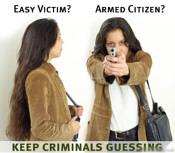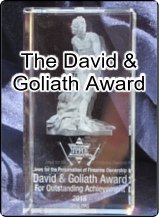

Do Civilians Armed With Guns Ever Capture, Kill,
or Otherwise Stop Mass Shooters?
![]()
By Eugene Volokh, Law professor UCLA, December 14, 2012. The Volokh Conspiracy
Article source
 Backers of laws that let pretty much all law-abiding carry concealed guns in public places often argue that these laws will sometimes enable people to stop mass shootings. Opponents occasionally ask: If that's so, what examples can one give of civilians armed with guns stopping such shootings? Sometimes, I hear people asking if even one such example can be found, or saying that they haven't heard even one such example.
Backers of laws that let pretty much all law-abiding carry concealed guns in public places often argue that these laws will sometimes enable people to stop mass shootings. Opponents occasionally ask: If that's so, what examples can one give of civilians armed with guns stopping such shootings? Sometimes, I hear people asking if even one such example can be found, or saying that they haven't heard even one such example.
Naturally, such examples will be rare, partly because mass shootings are rare, partly because many mass shootings happen in supposedly "gun-free" zones (such as schools, universities, or private property posted with a no-guns sign) in which gun carrying isn't allowed, and partly for other reasons. Moreover, at least some examples are contested, because it might be unclear -- as you'll see below -- whether the shooter had been planning to kill more people when he was stopped. But here are instances that I have seen, not counting killings stopped by people who were off-duty police officers (or police officers from other jurisdictions) at the time of the shooting.
1. In Pearl, Mississippi in 1997, 16-year-old Luke Woodham stabbed and bludgeoned to death his mother at home, then killed two students and injured seven at his high school. As he was leaving the school, he was stopped by Assistant Principal Joel Myrick, who had gone out to get a handgun from his car. I have seen sources that state that Woodham was on the way to Pearl Junior High School to continue shooting, though I couldn't find any contemporaneous news articles that so state.
2. In Edinboro, Pennsylvania in 1996, 14-year-old Andrew Wurst shot and killed a teacher at a school dance, and shot and injured several other students. He had just left the dance hall, carrying his gun -- possibly to attack more people, though the stories that I've seen are unclear -- when he was confronted by the dance hall owner James Strand, who lived next door and kept a shotgun at home. It's not clear whether Wurst was planning to kill others, would have gotten into a gun battle with the police, or would have otherwise killed more people had Strand not stopped him.
3. In Winnemucca, Nevada in 2008, Ernesto Villagomez killed two people and wounded two others in a bar filled with three hundred people. He was then shot and killed by a patron who was carrying a gun (and had a concealed carry license). It's not clear whether Villagomez would have killed more people; the killings were apparently the result of a family feud, and I could see no information on whether Villagomez had more names on his list, nor could one tell whether he would have killed more people in trying to evade capture.
4. In Colorado Springs in 2007, Matthew Murray killed four people at a church. He was then shot several times by Jeanne Assam, a church member, volunteer security guard, and former police officer (she had been dismissed by a police department 10 years before, and to my knowledge hadn't worked as a police officer since). Murray, knocked down and badly wounded, killed himself; it is again not clear whether he would have killed more people had he not been wounded, but my guess is that he would have.
So it appears that civilians armed with guns are sometimes willing to intervene to stop someone who had just committed a mass shooting in public. In what fraction of mass shootings would such interventions happen, if gun possession were allowed in the places where the shootings happen? We don't know. In what fraction would interventions prevent more killings and injuries, as opposed to capturing or killing the murderer after he's already done? We don't know. In what fraction would interventions lead to more injuries to bystanders? Again, we don't know. Finally, always keep in mind that mass shootings in public places should not be the main focus in the gun debate, whether for gun control or gun decontrol: They on average account for much less than 1% of all homicides in the U.S., and are unusually hard to stop through gun control laws (since the killer is bent on committing a publicly visible murder and is thus unlikely to be much deterred by gun control law, or by the prospect of encountering an armed bystander).
Still, people have asked for examples of some shootings in which a civilian armed with a gun intervened and brought down the shooter -- so here they are.
![]()
JPFO footnote: - Since the events of Sandy Hook School 12/14/12 it may be easily forgotten that just three days prior, a shooting occurred on 12/11/12 at the Clackamas Town Center Mall in Oregon, with two people being killed before the shooter shot himself. What was not reported, apart it seems from just only one Portland TV station, KGW, there was someone there legally carrying concealed. There is a short article report covering this.
By all accounts the CCW individual had his gun out from behind cover, which was after the two fatal shootings had already occurred, and had the shooter in his sights. He paused briefly due to the possible danger of hitting someone behind the shooter at which point the shooter saw him and immediately took his own life. The point to be noted is that here was someone available and potentially in a position to have possibly taken control had things continued further. No such person was on hand at the Sandy Hook school.
![]()



































